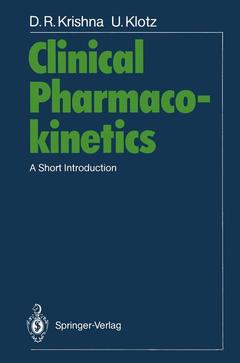Clinical Pharmacokinetics, Softcover reprint of the original 1st ed. 1990 A Short Introduction
Langue : Anglais
Auteurs : Krishna Devarakonda R., Klotz Ulrich

The first part of this book enables the reader to be familiarized with basic concepts of pharmacokinetics (Absorption, Distribution, Metabolism and Excretion - ADM E) following single dose administration. In this part these principles are applied to clinically relevant situations, namely, multiple or (sub) chronic administration. In day to day practice besides acute drug response, often a longer duration of action is desired. This situation needs the under standing of changes in pharmacokinetics of drugs upon repeated administra tion, and the dosage regimen has to be accordingly adjusted for achieving uniform therapeutic levels for desired period of time. 2 Multiple dosing The basic mathematical relationships applicable to single dose administration kinetics are also valid (with slight modifications) for multiple dose kinetics. In multiple dose therapy the ultimate purpose is to achieve a steady drug effect or response with minimum side effects. As mentioned before, this can be achieved in most cases by maintaining the plasma concentrations in therapeutic range for required number of hours or days. This may be considered as a general rule with an exception of nitrates, in which case the concentrations during the interval between two doses (called "dosing interval") should fall below a critical threshold level, such that tolerance does not develop. A drug is commonly administered in fixed doses at constant intervals of time so that the amount lost through elimination is replaced after each dose.
I: Basic pharmacokinetics.- Historical note.- 1 Introduction and definitions.- 1.1 Mathematical basis.- 1.1.1 Linear pharmacokinetics.- 1.1.2 Nonlinear pharmacokinetics.- 1.2 Pharmacokinetic models.- 2 Absorption.- 2.1 Absorption mechanisms and physico-chemical factors.- 2.2 Physiological factors.- 2.3 Pharmacokinetic calculations.- 3 Distribution.- 3.1 Plasma protein binding.- 3.1.1 (Patho)-physiological changes in protein binding.- 3.2 Tissue binding.- 3.3 Distribution volume.- 3.3.1 Factors influencing volume of distribution.- 4 Elimination.- 4.1 Half-life and clearance.- 4.2 Renal elimination.- 4.3 Hepatic elimination.- 4.4 Presystemic elimination and bioavailability.- 4.5 Other elimination processes.- 4.6 Kinetics of metabolism.- II: Pharmacokinetic principles and their clinical significance.- 1 Introduction.- 2 Multiple dosing.- 2.1 Infusion.- 2.2 Repeated dose administration.- 2.3 Accumulation.- 3 Drug interactions.- 3.1 Absorption interactions.- 3.2 Distribution interactions.- 3.3 Elimination interactions.- 4 Concentration — effect relationships.- 4.1 Individual pharmacokinetics.- 4.2 Population kinetics.- 4.3 Therapeutic plasma level monitoring.- 4.4 Individual dose determination.- 4.5 Effect kinetics.- III: Appendix.- 1 Recommended pharmacokinetic symbols, definitions and dimensions.- 2 Glossary.- 3 Tables with pharmacokinetic data.
Date de parution : 07-1990
Ouvrage de 149 p.
15.5x23.5 cm
Thèmes de Clinical Pharmacokinetics :
© 2024 LAVOISIER S.A.S.



